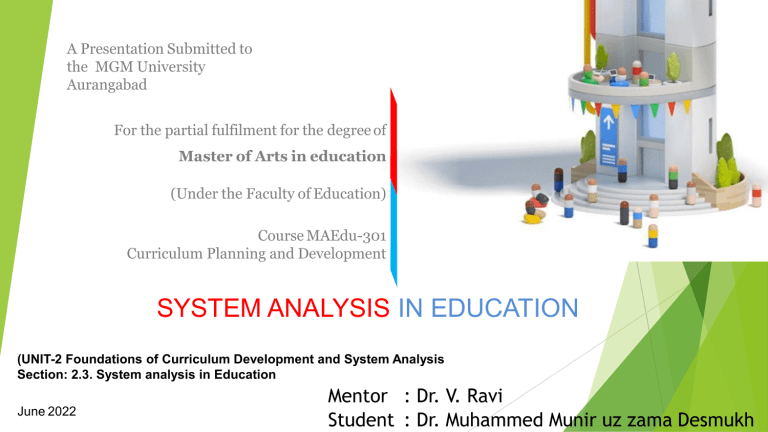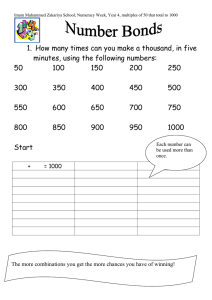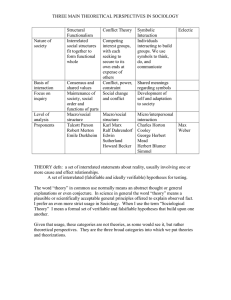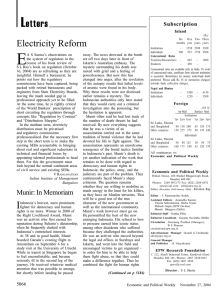
A Presentation Submitted to the MGM University Aurangabad For the partial fulfilment for the degree of Master of Arts in education (Under the Faculty of Education) Course MAEdu-301 Curriculum Planning and Development SYSTEM ANALYSIS IN EDUCATION (UNIT-2 Foundations of Curriculum Development and System Analysis Section: 2.3. System analysis in Education June 2022 Mentor : Dr. V. Ravi Student : Dr. Muhammed Munir uz zama Desmukh SYSTEM ANALYSIS IN EDUCATION SYSTEMS ANALYSIS AND EDUCATION System means a set of Interrelated Factors that are used together to produce an output System Analysis involves the study of change in the output due to a variety of changes in the involved variables and a combination of variables. Curriculum as a system has elements like input, process & output. J. A. Kershaw and R. N. McKean, RAND CORPORATION, OCTOBER 1959. Muhammed Munir uz zama Desmukh THE CONCEPT OF SYSTEM It is a mode of description, which explains the whole or an aspect of an object in terms of a set of interacting elements. A system is a group of interacting or interrelated elements that act according to a set of rules to form a unified whole. A system, surrounded and influenced by its environment, is described by its 1. Boundaries 2. Structure 3. Purpose Practically a system is expressed by its functioning. THE CONCEPT OF SYSTEM ANALYSIS It is a problem solving technique that improves the system and ensures that all the components of the system work efficiently to accomplish their purpose System Analysis enables comprehension of complicated structures. It Allows for better management implementation and changes. of It Aligns the curriculum with its objectives and priorities. Minimizes issues and reduces the work THE OBJECTIVES OF SYSTEM ANALYSIS OBJECTIVES OF SYSTEM ANALYSIS? 1) To determine specific needs. 2) Discuss approaches and tasks. 3) Evaluate tools and techniques. 4) Use appropriate methods and techniques CURRICULLUM AS A SYSTEM Curriculum can be of two types: 1. Macro curriculum 2. Micro curriculum Macro gives you the generic rules or guidelines that schools will have to follow for attaining the curricular goals/objectives Micro is very specific to subjects and the learning expectations Hence, there is total interaction within the curriculum: A. Between the stake holders, learning content, needs and learning outcomes B. Within the subjects Hence Curriculum is a system Muhammed Munir uz zama Desmukh FEATURES OF CURRICULUM AS A SYSTEM The Curriculum as a system will have the following features: 1. Parts : a. Learning Content b. Learning Experiences c. Learning Outcomes 2. Whole : These all interact to make the whole 3. Interdependent: These all are interdependent to construct the whole 4. Goals: These all work together towards fulfilling the goals Learning Content Learning Experiences Learning Outcomes Curriculum Fulfilment of Goals WHEN CURRICULUM BECOMES A SYSTEM • It defines Purpose and Goals • Results in Continuous Assessment and Quality Improvement • Generates a Rational Sequence • Makes strategy for Teaching And Learning SYSTEM MAKES EVERYTHING SYSTEMATIC • Helps in the selection of Learning Experiences • Introduces the process of Curriculum Development • Helps in Continuous and Comprehensive Education WHY & HOW CURRICULUM AS A SYSTEM? • • • • Accountability Unity Continuity Quality How do you produce such a system of curriculum? There are four phases for the production of the system model 1. Conceptualizing phase 2. Contextualizing phase 3. Implementing Phase/operational phase 4. Evaluating Phase/institutionalizing phase SYSTEM ANALYSIS IN EDUCATION What is system analysis in education? It is a process of: • Collecting and Interpreting Facts • Identifying the Problems • Decomposition of a system into its components Essentially, systems analysis is the comparison of alternative means of carrying out some function, when those means are rather complicated and comprise a number of interrelated elements. The purpose of system analysis is to compare one system with other and see which is better APPROACH TO SYSTEM ANALYSIS IN EDUCATION By system, a set of interrelated factors is meant which are used together to produce an output. In a successful system analysis, the analyst can vary the inputs and note the effect on both cost and output and decide which system is better. Here also one curriculum system can be analysed on the basis of the input and the resources required for it and the cost involved in that. And it can be compared with any other curriculum system This approach of system analysis forces the user to use explicitly all possible variables in terms of inputs, design processes and obtain the output CHARACTERISTICS OF SYSTEM ANALYSIS IN EDUCATION • CENTRAL OBJECTIVE • ORGANIZATION • INTERACTION • INTERDEPENDENCE • INTEGRATION Relationship with System and Environment INPUT: Flow from the environment to the system OUTPUT: Flow from the system to its environment Boundaries of the Educational System may exist physically or conceptually. ELEMENTS OF SYSTEMS APPROACH IN EDUCATION Involving Communities. ... Strengthening Capacity and Capability. ... Scaling Practice. ... Sustaining outcomes. ... Values and Principles THANK YOU Muhammed Munir uz zama Desmukh






